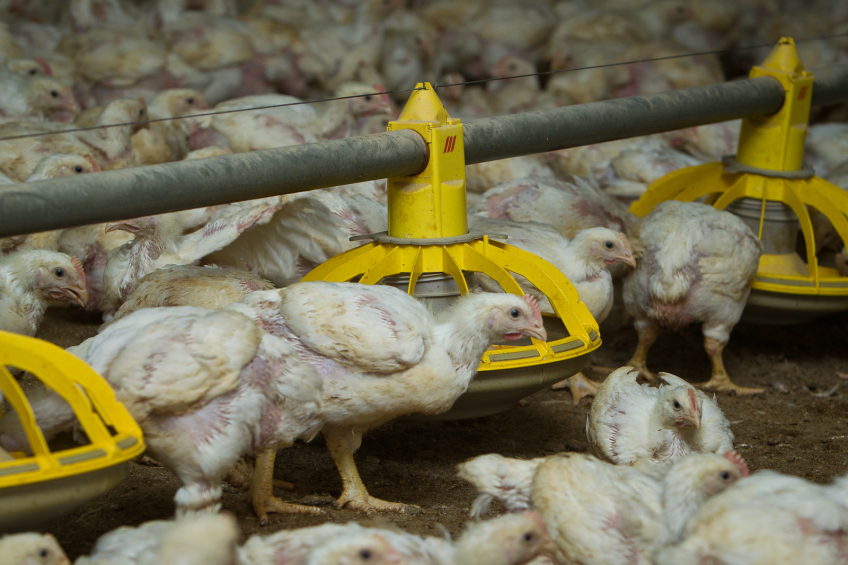Improving performance during mycotoxin exposure

In the past, binding of mycotoxins was seen as the solution for optimal animal performance. Nowadays, more sophisticated approaches lead the way, including support of gut health and optimally functioning immune systems and detoxification mechanisms.
By Yvonne van der Horst, Selko Feed Additives and Anna-Katharina Oudshoorn, Nutreco R&D, the Netherlands
Mycotoxins are often present in raw materials and compound feeds and have a large impact on animal performance. Over 300 mycotoxins are identified, and a large number is still unknown. Aflatoxins (AFLA), T-2 toxin (T2), ochratoxin A (OTA), and fumonisins (FUM) are the most often occurring mycotoxins in poultry feed and in many cases a combination of these mycotoxins is found. The impact of multiple mycotoxin presence in feed is often underestimated, since they can have a synergistic effect.
Symptoms caused by mycotoxins in animals are oftentimes not recognised as mycotoxin related, since they can affect the immune system, gut barrier or oxidative status. Other symptoms are for example, increased organ size and impaired tissue integrity. Therefore, mycotoxins in raw materials and feed can substantially affect animal performance.
Four support strategies
Binding of mycotoxins only, usually
is not sufficient. Therefore multiple strategies are needed to help poultry maintain a good health status during exposure to mycotoxins. Selko Feed Additives has developed an integrated approach in the Toxo portfolio to support animals in maintaining a good health status during exposure to a broad spectrum of mycotoxins. These four strategies have proven effects in science and in vivo studies.
Effective binding capacity.
Trial results have shown that a combination of specific smectite clays have the highest Q-max value for aflatoxin B1 (AFB1), followed by single smectites and bentonites (Table 1). A recent in vitro study done at the Samitec Institute in Santa Maria, Brazil showed that Toxo at 0.5% inclusion rate showed an adsorption coefficient of 98.40%, compared to the standard of AFB1 (1.0 μg/ml) in artificial gastric juice at pH3.0.
Supporting gut barrier function.
A healthy gut and an optimal functioning gut barrier are essential for animal health and performance. Mycotoxins are known to affect the intestinal wall, which may lead to an impaired barrier function and malabsorption of nutrients. Since not all mycotoxins can be neutralised by binding, it is important to include additional mechanisms that go beyond binding to support a strong intestinal barrier. Toxo-XL contains glucose biopolymers which have shown to reduce tight junction breakdown by mycotoxins and therefore contribute to a strong intestinal barrier.
Maintaining a healthy immune system.
Most mycotoxins are immune suppressors, which is often underestimated in livestock production. Literature has shown that different mycotoxins can influence the immune system when they are absorbed into the blood stream. The broad spectrum mycotoxin protection strategy includes specific activated ß-glucans, which are known for their positive effects on the immune system.
Support detoxification mechanisms.
Mycotoxins ingested by the animal via feed need to be detoxified in the body. Specific vitamins and antioxidants are included, which up-regulate enzymes involved in all three phases of the detoxification process as well as reduce oxidative stress.
In vivo results
The efficacy of the broad spectrum mycotoxin protection strategy has been studied in a series of trials in poultry. The studied birds were challenged with very high levels of aflatoxins only (2.8ppm), very high levels of a mixture of aflatoxins (2.8ppm), fumonisins (100ppm) and T-2 toxin (1.5ppm) or high levels of a mixture of aflatoxins (1.4ppm), fumonisins (50ppm) and
T-2 toxin (0.75ppm). Consistent and synergistic negative effects of single and multiple mycotoxins on feed intake and animal performance parameters were found. This supports the need for a broad spectrum solution for maintaining a good health status and performance when mycotoxins are present in the feed at different levels. In all studies, a control group (no treatment) and a control group with 0.5% Toxo-XL in the
diet was included and no significant
differences were found between these two groups.
Better feed intake
Supplementation of Toxo-XL at different levels in the feed resulted in significantly better feed intake compared to the mycotoxin challenged groups in two out of three studies (up to +28.5%) (Figure 1). Feed conversion ratio (FCR) was not affected by the inclusion of mycotoxins. This resulted in significantly higher bodyweight at 21 days compared to the mycotoxin challenged group in all
studies (Figure 2). All studies showed a clear positive dose-response effect on these performance parameters.
Indicator in blood
Livers are often enlarged by mycotoxins, through different routes. Therefore, relative liver weight (RLW) can be used as an indicator of mycotoxin presence in the blood. RLW was significantly higher in the animals fed diets supplemented with mycotoxins compared to diets free of mycotoxins in all studies (Figure 3). When Toxo-XL was added to the diets, RLW was significantly lower compared to the mycotoxin groups. Levels of
plasma protein in serum indicate the presence of aflatoxins; the lower the
protein level, the more aflatoxins are present. Total plasma protein (TPP)
levels in serum were significantly lower in the mycotoxin groups compared to the control groups in all studies. In two out of three studies significantly lower TPP levels were found when 0.5%
Toxo-XL was included in the diets. These results demonstrate that Toxo-XL improves growth performance and the health status of broilers.
Multiple strategies
Since in practice poultry feed often
contains multiple mycotoxins, there is a need for broad spectrum mode of action products. Besides binding, additional strategies are needed to help birds in maintaining a healthy status during exposure to mycotoxins. Glucose
biopolymers support a healthy gut
barrier integrity in the presence of mycotoxins such as DON and OTA.
With these multiple strategies combined in a broad spectrum mycotoxin protection strategy it is possible to maintain optimal health and performance of birds and to contribute to increased financial results for poultry meat producers.
World Poultry, Volume 30, Source 10












